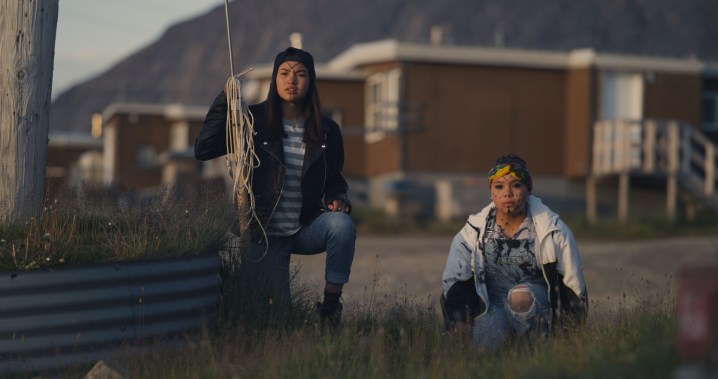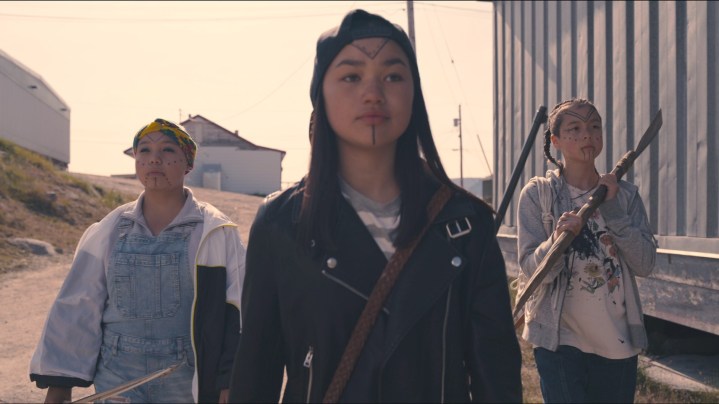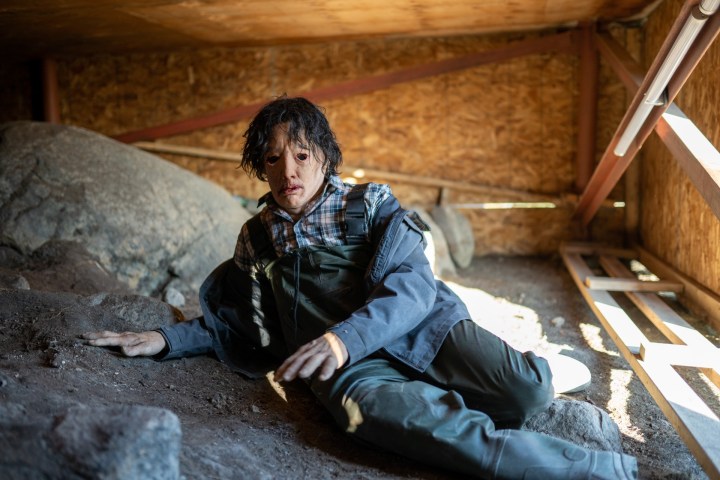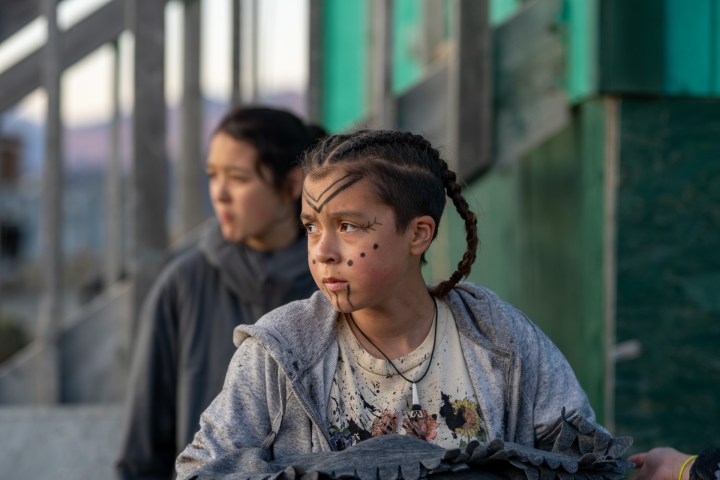Audiences love stories that pit plucky kids against horrible monsters — whether it’s aliens, zombies, ghosts, or various other supernatural threats. There’s so much love for these stories, in fact, that it takes a special kind of film to stand out in the crowded “kids vs. monsters” genre these days.
Director Nyla Innuksuk’s Slash/Back is one such film, and it delivers a uniquely clever, creepy-fun adventure, led by a talented cast of young actors.

Rough but real
The first feature-length film from Innuksuk, Slash/Back is set and shot in the Inuit hamlet of Pangnirtung in Nunavut, Canada. The film follows a group of young girls, played by Tasiana Shirley, Alexis Wolfe, Nalajoss Ellsworth, and Chelsea Prusky, who discover a deadly alien creature threatening their tiny, remote community. They take it upon themselves to stop the extraterrestrial invader with a mix of makeshift weapons, horror-movie savvy, and the skills they’ve learned growing up in the place they call “Pang.”
Nearly the entire cast of Slash/Back was recruited from Pangnirtung and the surrounding regions of Nunavut, and although their lack of acting experience is evident in the film, Innuksuk smartly weaves that quality into the energy of the film. The main characters act and talk like the kids they are, frequently lamenting the boredom of life in Pang and discussing their respective local crushes, usually while staring at a phone screen. The casualness of the actors’ approach adds a sense of authenticity to the adventure Innuksuk crafts around them, and even gives the film a documentary-like vibe at times, particularly in those moments when the alien-fighting kids are simply being, well … kids.
When the action picks up, the girls handle the frantic moments even more comfortably, delivering some fun performances as the self-appointed — and in some cases, reluctant — defenders of their village. The actors throw themselves into both the scares and campiness of it all with an entertaining blend of dramatic (and sometimes amusingly overdramatic) sincerity and standard-issue teenage apathy.

Smart sourcing
In the easiest comparisons to make with Slash/Back, the film delivers a mash-up of Joe Cornish’s 2011, London-set alien invasion film Attack the Block and John Carpenter’s iconic, 1982 polar thriller The Thing.
Like Attack the Block, Innuksuk’s film puts the fate of a community that doesn’t seem outwardly united into the hands of the most unlikely of saviors. And much like the adolescent gang in Cornish’s film does, the kids of Slash/Back could not seemingly care less about their little village. However, when circumstances (or more accurately, deadly alien invaders) force them to reckon with their real feelings about their neighbors, a subconscious switch is flipped that gives them a powerful sense of purpose and allegiance to the community they once seemed desperate to leave.
That evolution is particularly fun to watch with the young cast of Slash/Back, whose rough-around-the-edges acting makes the characters’ pivot from angsty teenagers to alien-vanquishing heroes feel a little more honest, as the roles they play never feel that far distanced from their reality.

Slash/Back also takes plenty of cues from The Thing in the sense of isolation its remote setting and Innuksuk’s camera create, as well as some of the film’s creature designs, which involve piles of slimy tentacles and gruesome practical effects. The film’s extraterrestrial monsters wear the skin of their victims — both human and animal — as they invade Pang, and the film is at its best when it’s leaning into the work done by contortionists and clever costuming to give the film’s creatures a terrifying, physical presence in the kids’ world.
Unfortunately, that gritty, ’80s horror aesthetic of the aliens takes a bit of a hit when the film relies too heavily on digital effects, as those elements often feel a bit too polished and sharp for the world around them.

People and place
Innuksuk also makes excellent use of sound in Slash/Back, relying almost entirely on traditional music and Indigenous musicians to establish the film’s sense of place and culture. In one particularly effective example, elements of traditional Inuit throat-singing are layered over several tense moments, and the pairing elevates a creepy scene to something far more chilling, all while deepening the story’s connection to its setting.
Innuksuk also manages to embed plenty of sociopolitical themes in Slash/Back that take it beyond a simple creature feature, offering a more well-rounded experience for anyone looking for more out of it. As its “kids vs. monsters” saga plays out, the story touches on the relationship between different generations of Indigenous peoples and their culture and traditions, wealth disparity within remote communities like Pang, and these communities’ connection to the rest of the world, among other heady topics that are addressed with an impressively subtle touch.
With Slash/Back, audiences willing to look past the film’s no-frills approach to filmmaking will find a rich, wonderfully textured story rooted in the place and people of its setting. They’ll also find an amazingly fun, funny — and yes, genuinely creepy at times — horror film about plucky kids battling terrifying alien tentacle monsters from space.
That’s the sort of double feature you don’t get from every scary movie out there, and it’s what makes Slash/Back something truly special.
Directed by Nyla Innuksuk, Slash/Back will be available October 21 in theaters and via on-demand video.





